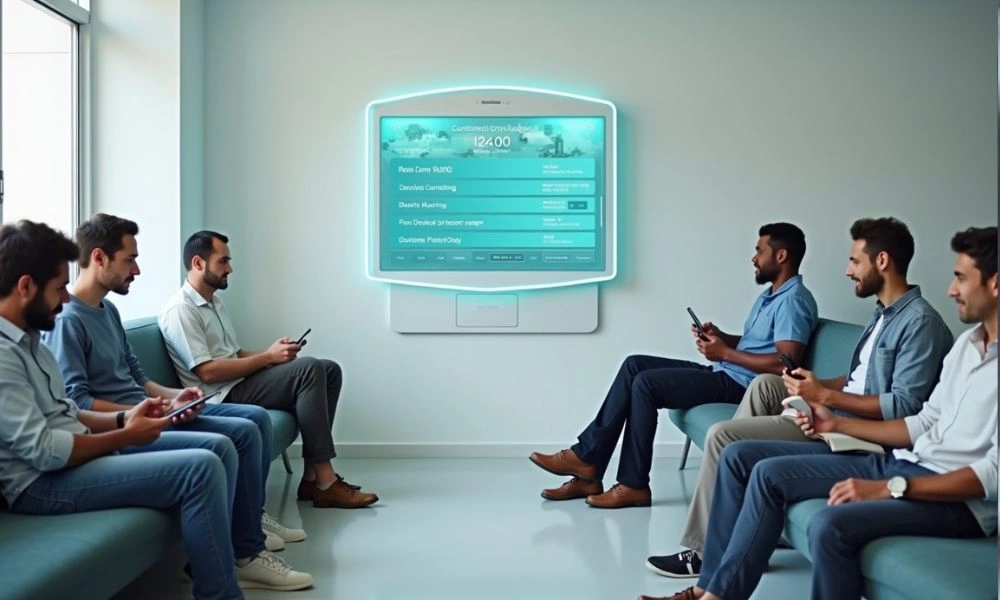
What Is a Smart Hospital?
A Smart Hospital leverages cutting-edge technologies—AI, IoT, cloud computing, automation, data analytics, and integrated software—to streamline all hospital functions, from clinical operations to administrative processes and patient experiences.
Smart hospitals are not merely digital—they are smart, always learning and improving to optimize workflows, eliminate waste, and improve outcomes.
Why Should Clinics & Small Hospitals Care About Smart Hospital Models?
You might be wondering, “We’re not a large city hospital. We don’t need smart systems.” That’s precisely why smart technology is even more important. Smaller clinics and mid-sized hospitals have more competition, fewer people, and smaller budgets. Smart solutions such as Sehat Pro assist:
- Streamline repetitive tasks (billing, appointment scheduling, record-keeping)
- Decrease waiting times
- Improve patient communication
- Facilitate improved clinical decisions with real-time information
Smart Hospital Ideas You Should Know
Let’s dissect the most significant innovations that are transforming smart hospitals and why you should adopt them today.
1. Integrated Digital Infrastructure
Smart hospitals are founded on connected systems—where EMR, billing, lab, pharmacy, radiology, and appointments all operate in harmony. This translates to:
- No more duplicate paperwork
- One-click access to entire patient history
- Effortless internal communication among departments
Sehat Pro functions as the central hub of this infrastructure, bringing it all under one single intuitive dashboard.
2. IoT-Powered Medical Devices
Internet of Things (IoT) medical equipment and devices such as intelligent beds, wearables, and networked diagnosis machines offer “anytime, anywhere” patient monitoring, alerts, and early warnings. This minimizes the likelihood of human error and maximizes patient safety.
For instance:
- Intelligent infusion pumps automatically regulate dosage
- Heart rate and oxygen level monitors warn doctors of critical changes
- RFID tags monitor equipment and inventory
3. AI and Machine Learning in Diagnosis
Artificial Intelligence is not a buzzword. AI assists:
- Detect disease precursors (e.g., via radiology scans)
- Anticipate patient readmissions
- Tailor treatment plans based on patient history
When combined with clinic management software such as Sehat Pro, it equips physicians with smart decision support—saving time and lives.
4. Automated Processes & Task Management
Intelligent hospitals operate based on automated processes. These include:
- Auto-allocating patient beds
- Auto-generating invoices
- Auto-sending appointment reminders
- Auto-updating medical charts
This is not about replacing humans, but releasing your staff to engage in actual patient care—not data entry.
5. Remote Patient Monitoring & Telemedicine
The post-COVID period revealed that patients need care beyond clinic walls. Using wearable devices and telemedicine platforms:
Chronic disease patients (e.g., diabetes, high blood pressure) can be monitored remotely
- Physicians can consult virtually, freeing up in-clinic rush
- Emergency alerts can be activated when a patient’s vital signs dip
Telehealth integration within Sehat Pro makes this easy, scalable, and secure.
6. Cloud-Based EMR Systems
Cloud-based records are available anywhere—whether the physician is within the clinic, home, or on the road. It also:
- Secures data via encrypted backups
- Facilitates collaboration across branches or specialists
- Makes updates and patches automatic
Sehat Pro leverages secure cloud infrastructure for simplicity, compliance, and reliability.
7. Smart Appointment & Queue Management
Patients despise waiting. Smart queue systems automatically:
- Assign doctors according to patient flow
- Provide patients SMS alerts regarding delays
- Prevent waiting area congestion
Add this with online scheduling and digital reception, and your patient satisfaction ratings will go through the roof.
8. Predictive Analytics for Hospital Operations
Astute hospitals don’t respond—they foresee. With data, software can predict:
- Peak periods and patient volumes
- Shortages of medicine
- Chances of patient readmission
This optimizes staff scheduling, inventory management, and prevents bottlenecks.
9. Voice and Chatbot Assistants
Smart assistants embedded within hospital websites or apps manage:
FAQs
- Booking appointments
- Refilling prescriptions
- Updating lab reports
You can free your staff while staying accessible to patients 24/7 with AI-driven chatbots.
10. Energy Efficiency and Intelligent Building Management
Your hospital infrastructure can also be smart:
- Smart lighting and HVAC systems minimize energy consumption
- Automated doors and elevators for enhanced hygiene
- Smart sensors flag maintenance requirements early on
These save operating expenses— freeing budget for enhanced patient care.
Real-Life Advantages of Smart Hospital Models
Let’s get real. Here’s what you have when you operate your building smart:
Less Administrative Burden
Streamlined billing, scheduling, and reports result in fewer errors and less overtime.
Improved Patient Experience
Shorter wait times, online interfaces, and quicker check-in make patients happier and more likely to return.
Increased Staff Productivity
Physicians and nurses spend more time on patient care rather than paperwork.
Fewer Readmissions
Remote monitoring and AI-powered warnings detect problems before they become serious.
Higher Revenue
Improved throughput, follow-up visits, and fewer losses generate more reliable cash flow.
How Sehat Pro Transforms Your Clinic into a Smart Clinic?
Sehat Pro is your digital transformation partner. Our software is designed for doctors, clinics, and small hospitals across Asia, equipping them to compete with larger institutions.
With Sehat Pro, you can:
- Digitize patient history
- Automate reminders and follow-ups
- Monitor income, stock, and employee performance
- Provide telemedicine and remote treatment
- Create insights with dashboards in real time
And all of it with absolutely no technical complexity.
Future of Smart Hospitals: What to Expect
The transformation doesn’t end. In the coming years, look for:
- Blockchain for safe patient data sharing
- Digital twins of hospital settings for design
- Augmented Reality (AR) for operations and training
- Increased wearable integration for remote care in real time
- Emotion AI that can detect patient stress and notify nurses
With Sehat Pro, you’ll always be future-ready.
Conclusion: It’s Time to Get Smart—Now
If you operate a clinic or hospital, your patients already expect more—faster speed, greater connection, and greater trust. The only way to keep pace is to adopt smart hospital technologies.
It’s not size that matters. It’s efficiency, connectivity, and patient-centricity.
Sehat Pro is here to arm you with everything you need to establish an intelligent clinic today, without costly equipment and cumbersome setups.
Frequently Asked Questions (FAQ)
A smart hospital uses advanced technologies like AI, IoT, cloud computing, and automation to streamline operations, improve patient outcomes, and deliver faster, more efficient healthcare services.
Yes, Sehat Pro is designed for modern, tech-enabled clinics and hospitals, offering features like automated workflows, cloud-based access, and EMR integration to support smart healthcare environments.
AI helps analyze patient data, predict health outcomes, optimize treatment plans, and support faster diagnostics, making care more proactive and resource-efficient for doctors and clinics alike.
No, smart hospital features can be scaled. Small clinics and local hospitals can implement core tools like Sehat Pro to benefit from automation, digital records, and remote monitoring.
Female founders are creating focused solutions in maternal care, mental health, and community wellness—improving healthcare access and outcomes for women and families across Asia.



